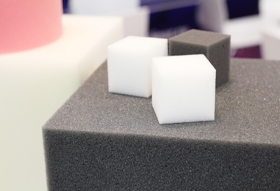Foam News: Foam to plastic

Manufacturers across the globe, regardless of their sector, are growing increasingly conscious of their environmental impact. This is not just in terms of their production processes, but in relation to what happens to a product when it reaches the end of its lifecycle. For the foam sector, companies are acutely aware of the new need to develop both environmentally friendly products, and to ensure that much is done to minimise the long-term impact of their foam.
This change in attitude has largely been driven by the number of foam research and innovation projects currently underway around the globe. One of the most recent developments is that of Northwestern University and the University of Minnesota, who have worked to develop a new method for upcycling polyurethane foams. To the common consumer, polyurethane foam is mostly found in household insulation, upholstered furniture such as sofas and cushions, as well as foam mattresses.
The key motivator for this research was to establish whether waste polyurethane foam could be recycled into higher-quality rubbers and other hard plastics. Such materials are in demand for items including shoes, watch wristbands and for the durable wheels commonly found on shopping trolleys and skateboards. By developing a process that involves the mixing of waste polyurethane foam with a catalyst solution, a malleable foam material is then formed, ready to be made into a new product.
Before developing the new product, this material composition undergoes further processing to remove the air from the foam. Researchers leading this project term this process as 'twin-screw' extrusion, which aids the formation of the new product. Depending on the type of plastic to be created – a hard, durable plastic or a soft, flexible film – the process is altered accordingly. These materials are then created in the required shapes.

This is not the industry's first attempt at repurposing polyurethane foam into alternative materials. To counter the common environmental problem once caused by polyurethane foam being burned or landfilled, other organisations have attempted to compress such foams to remove the air. However, in doing so, this resulted in plastics that easily cracked or were unevenly blended. This new approach led by the Northwestern and Minnesota research teams has been widely praised, with the use of two interlinking, co-rotating screws able to both mix and re-shape the foam simultaneously to form a stable and durable product.
At Easyfoam, we are proud that our waste foam material is recycled back into reconstituted foam – a durable and eco-friendly material. We supply this foam to organisations and individuals alike who are seeking pub seating, gym mats and transport seating, for example. When recycled correctly, foam has an infinite durability and lifecycle, as its resilient structure allows for the recreation of materials that are just as durable and long lasting.
Our goal is to become the UK's most sustainable and environmentally foam manufacturer. Should you have any queries relating to our production processes and environmental ethos, please contact us.
